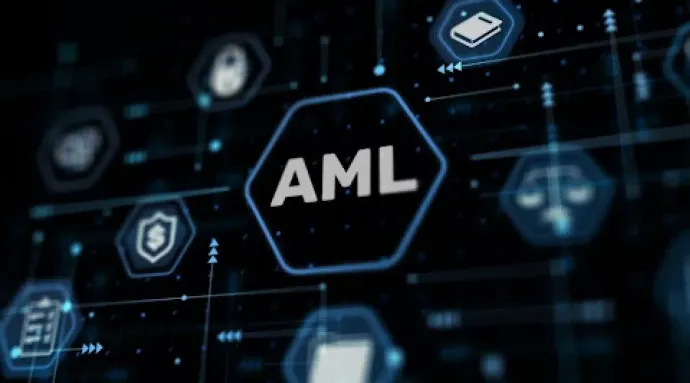Despite some believing that x402 and ERC-8004 are merely part of the larger narrative of the fusion of crypto and AI, they indeed unlock practical payment mechanisms between agents, laying the groundwork for large-scale applications.
Written by: Eli5DeFi
Compiled by: Chopper, Foresight News
In recent days, as the x402 narrative has gained momentum, interest in AI agents as a payment method has surged. But have you heard of ERC-8004?
Perhaps you missed the hype around x402, but don’t miss this important protocol.
What is ERC-8004?
ERC-8004 is an Ethereum-based protocol designed to establish trust, identity, discoverability, and reputation systems for AI agents, complementing the existing x402 agent payment infrastructure.
In simple terms:
x402 → Automates micro-payments for AI tasks
ERC-8004 → Provides on-chain identity and reputation tracking for AI agents
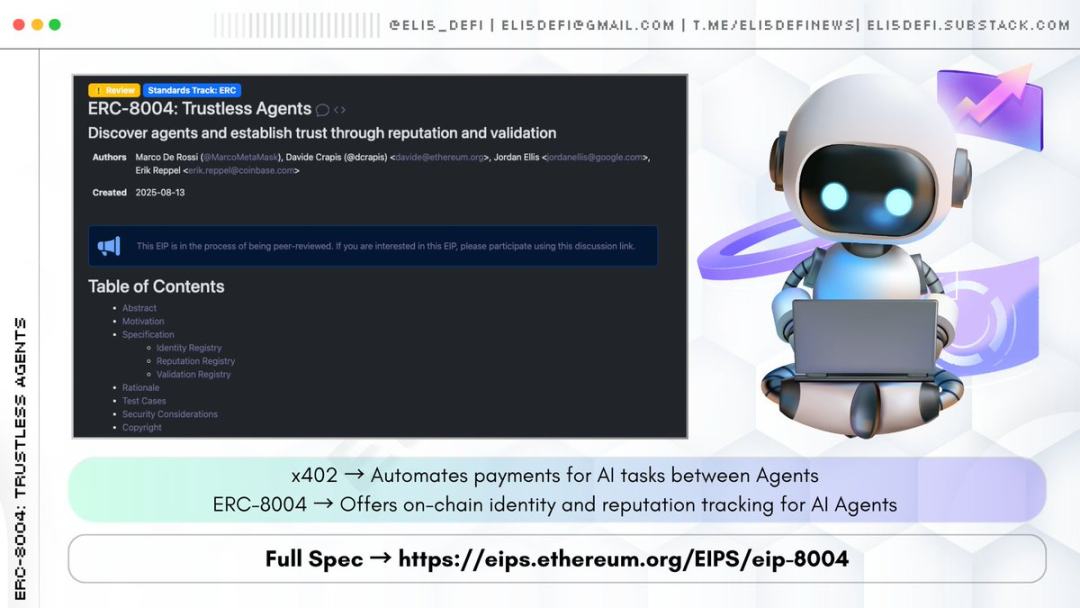
Why is ERC-8004 important?
ERC-8004 aims to create a distributed agent economy, helping AI development break free from centralized control.
It will build an AI system that is "permissionless, decentralized, censorship-resistant, and privacy-preserving," making Ethereum the underlying foundation for future AI agent collaboration.
Additionally, its importance is reflected in the following aspects:
Establishes an on-chain business registration and reputation system for AI agents, providing immutable public identities and historical records;
Reuses existing Ethereum (L1/L2) infrastructure, avoiding the need to create new blockchains and preventing redundant efforts;
Features a lightweight architecture, utilizing blockchain solely for visibility and data storage, with other functionalities deployed off-chain;
Achieves sustainability for the AI economy, supporting composability and scalable applications across infrastructures.
Tory explained the broader significance of ERC-8004, stating, "AI agents can cause harm, and through ERC-8004, agents with the 'cleanest' public records will ultimately prevail."
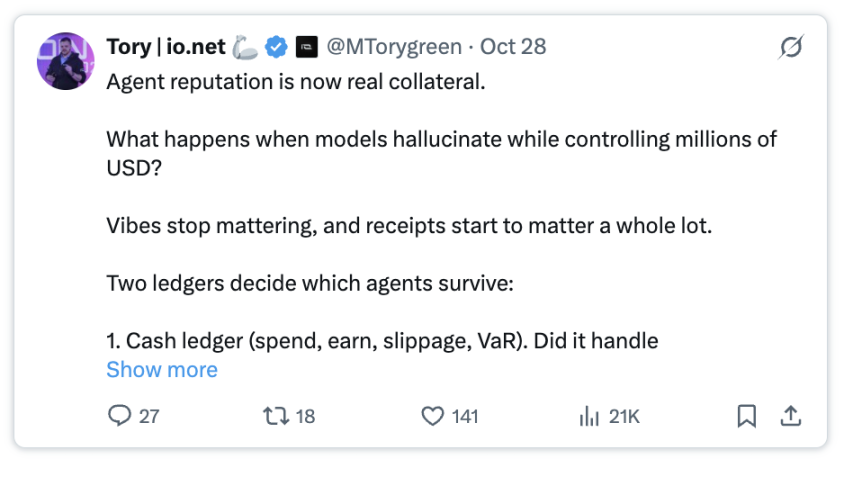
https://x.com/MTorygreen/status/1982900869860573399
How does ERC-8004 work?
The architecture of ERC-8004 is straightforward, consisting of three core on-chain registries:
Identity Registry. Each AI agent receives an ERC-721 NFT as an identity marker, viewable in any NFT wallet and transferable. This NFT is linked to an "agent card," containing the name, functions, and endpoints, facilitating quick discovery of compatible agents.
Reputation Registry. Builds a decentralized feedback system where clients and agents can submit evaluations based on x402 payment receipts, ensuring that only parties actually involved in transactions can comment, reducing fraudulent behavior. All data is public and supports customizable rating systems.
Verification Registry. For significant transactions, agents can request third-party verification—providing cryptographic-level behavioral proof through trusted execution environment (TEE) oracles, staking inference, or zero-knowledge machine learning proofs, similar to professional qualification certifications.
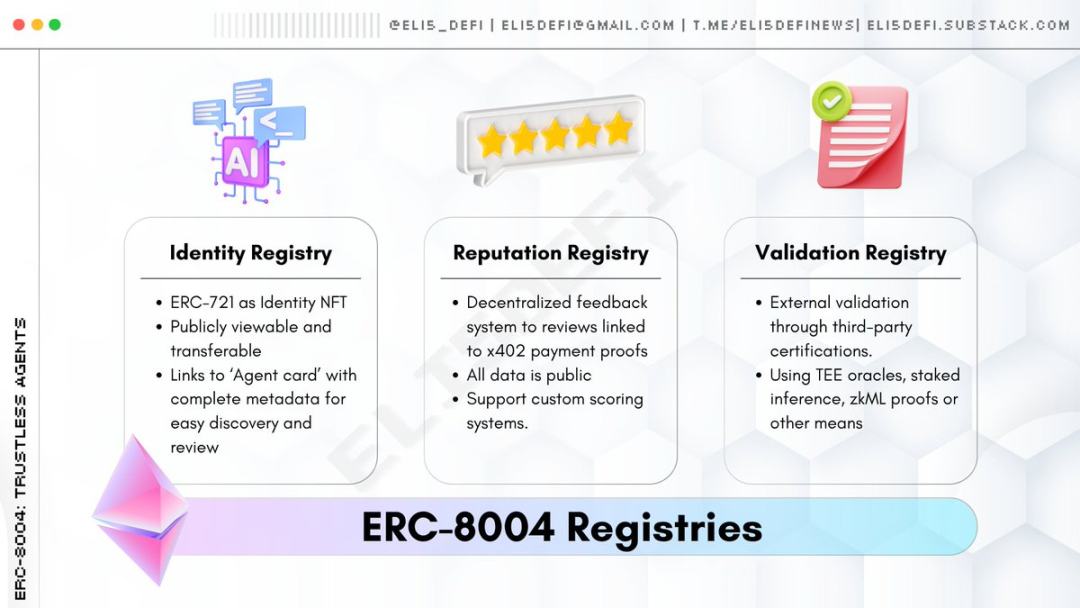
For example: Suppose you have an AI agent that needs to rebalance its portfolio by obtaining on-chain analytical data from other AI agents.
With x402, your agent can easily deposit $100 to request the service, but before payment execution, x402 cannot verify whether the agent providing the service is reliable; whereas ERC-8004 ensures transaction security through the following steps:
The identity registry allows your AI agent to verify the analyst's NFT identity and service scope;
The reputation registry provides positive evaluation records and completion rate proofs linked to past x402 payments;
The verification registry ensures that third-party verifiers have certified the quality of the report.
Once the verification record is on-chain, the escrowed funds are automatically released, and a reputation evaluation is added. This process creates a "trustworthy autonomous transaction" that x402 alone cannot achieve.
The x402 and ERC-8004 Ecosystem
In a previous article (https://x.com/eli5_defi/status/1978474979600879984), I provided a detailed analysis of the x402 ecosystem. The infrastructure of ERC-8004 extends across multiple layers, with some of the layers listed below:
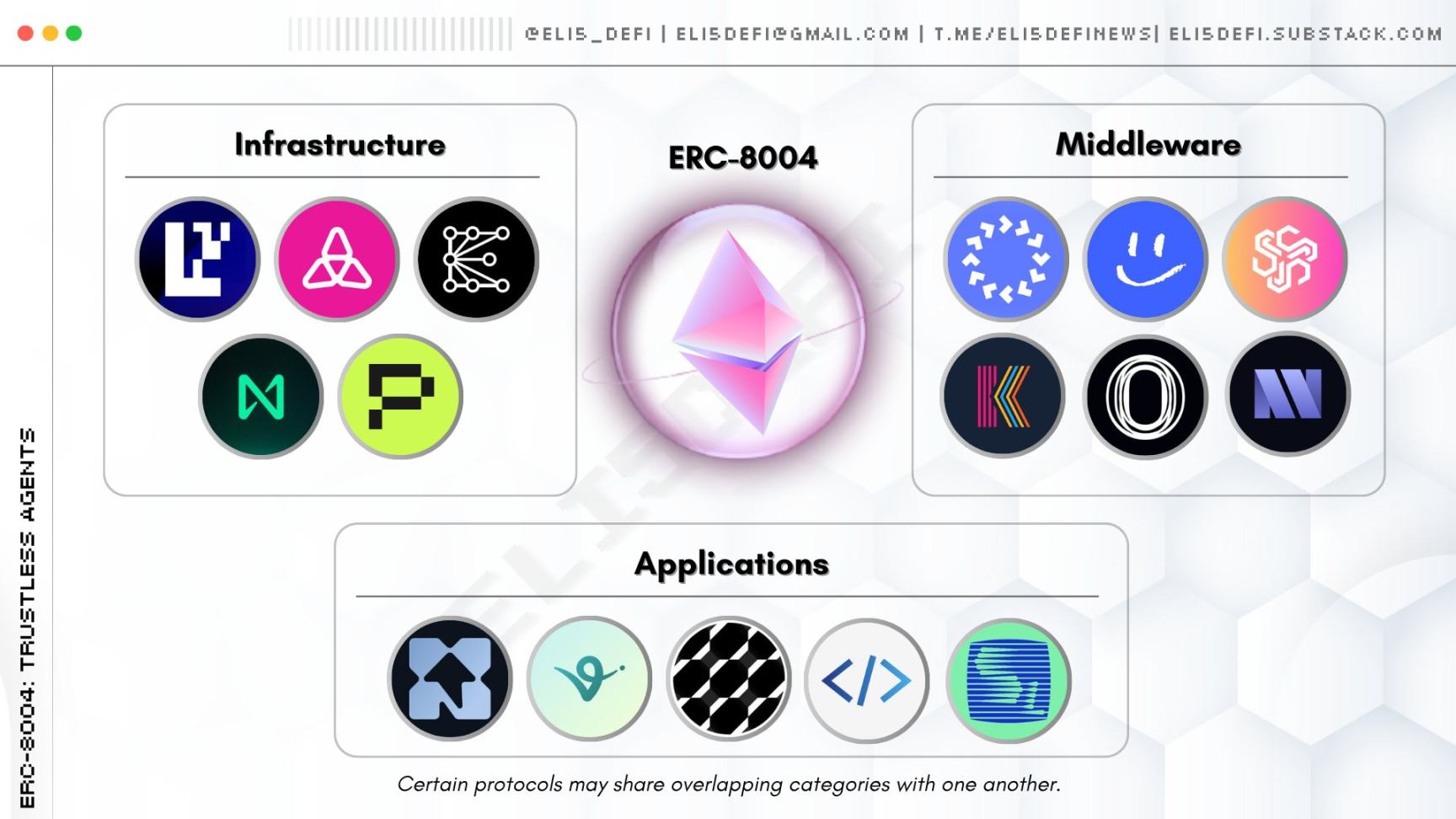
Infrastructure: EigenCloud, Taiko, Eternal AI, NEAR, Phala Network
Middleware: OpenServ, Unibase, S.A.N.T.A, Kinic AI, ChaosChain, NovaNet
Application Layer: Zyfai, Virtuals Protocol, Praxis, Cortensor, Semantic Layer
ERC-8004 Goes Beyond Finance
The financial sector is just the first step for "trustless agents"; the application scenarios of ERC-8004 extend far beyond financial transactions.
Creator Agents
Services include: copywriting, social media management, community operations, translation, image production, with selection criteria based on reputation and client evaluations.
Trading Agents
Support decentralized on-chain delegation, enabling DeFi portfolio rebalancing and yield optimization. Staking verifiers audit transaction results, with erroneous operations compensated through forfeiture mechanisms.
Analyst Agents
Provide market analysis, data scraping, tagging, and customer relationship management optimization services. Utilizing TEE technology, they can compute private data from multiple institutions without exposing original identifiers.
Game Agents
Create non-player characters across games, with persistent character settings and skills. Game invitations and character appearances are allocated based on reputation proofs.
Doctor Agents
Summarize electronic health record data, verify treatment guidelines, and draft medical records. Securely integrate lab data, imaging information, and pharmacy details through TEE technology, providing verifiable execution proofs for audits.
Personal Avatars
Utilize privacy-preserving AI memory to encrypt and store personal data in the cloud. With TEE technology, they achieve personalized services similar to centralized AI while ensuring privacy security.
Insurance Agents
Automate underwriting and claims processes using large language models. Staking verifiers validate decisions and evidence, with erroneous decisions refunded to users through forfeited funds.
Scheduling Agents
Handle flight, hotel, restaurant bookings, and route optimization. Service providers are selected based on reputation to ensure cost-effectiveness.
Laboratory Agents
Coordinate experimental processes through hardware security mechanisms, sign data output results, analyze within a TEE environment, and return verifiable, auditable results.
Conclusion
ERC-8004 was jointly proposed by Davide Crapis from the Ethereum Foundation, Marco De Rossi from MetaMask, Jordan Ellis from Google, and erik.eth from Coinbase (who is also a founder of x402), serving as an important complement to the x402 protocol.
The combination of x402 and ERC-8004 indicates that technological advancements can effectively merge payment systems with embedded on-chain verifiable trust, addressing real-world problems. While some believe that x402 and ERC-8004 are merely part of the larger narrative of the fusion of crypto and AI, they indeed unlock practical payment mechanisms between agents, laying the groundwork for large-scale applications.
免责声明:本文章仅代表作者个人观点,不代表本平台的立场和观点。本文章仅供信息分享,不构成对任何人的任何投资建议。用户与作者之间的任何争议,与本平台无关。如网页中刊载的文章或图片涉及侵权,请提供相关的权利证明和身份证明发送邮件到support@aicoin.com,本平台相关工作人员将会进行核查。



